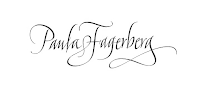Hello stamplings! Today I have a tutorial for you on how I made this zany collaged doll for the Black & White challenge over at the Lost Coast Portal to Creativity. You can use these same principles to help you plan and execute any sort of rubber-stamped collage.
1. Plan out the composition.
(As this piece was always intended to be in black & white only--no color--I chose images in various degrees of texture and blackness, striving for a variety of line and pattern.)
Gather the stamp images you'd like to use and start playing with them. You can stamp them and roughly cut them out to position them relative to each other...or sketch them on a piece of paper to approximate size...or use software such as Photoshop or InDesign to make a sketch.
I used InDesign, layering the images on top of each other very coarsely (not removing the opaque white backgrounds from each image) just to get an idea of what I wanted to do. My sketch looked like this:
Crude, right? But that's all you need to get the job done in the planning stages.
2) Decide on your focal point.
In all likelihood, this will be the image you stamp first--the one that appears on top of all the other layers in the collage, in the foreground. In my composition, it was the eyeglasses image.
3) Determine the order of operations.
If you have a fairly complex collage to build like this one (using more than say, three stamps), now you have to figure out the order in which you are going to stamp. The things that go behind, in the background, get stamped last. Determine what is "foreground" and what is "background," and proceed in a logical order.
4) Using your sketch as a blueprint...start stamping!
I recommend the use of a stamp positioner or stamp press tool such as the MISTI or the We R Memory Keepers press (which is what I used). This allows you to re-ink the stamp and get perfect coverage with subsequent impressions in case an image prints a little unevenly the first time. (When you are working on building a multi-step collage like this one, you don't want to wreck it with a faded-looking or partial print of one of the images!) These tools also allow you to place each stamp exactly where you want it to print--handy! You'll see what I mean below.
5) Cut a mask for each image as you work.
After you stamp each image on the "real" paper, stamp off onto some scrap paper, and cut that print out to use as a mask. I used repositionable adhesive to stick down my masks precisely over each image before stamping the next layer atop it.
TIP: Cut the masks juuuuust inside the image's outline--this avoids leaving a dreaded white halo around the masked image as you stamp over it, allowing you to get right up nice and close to abut the masked image with the image you are layering over (which will actually appear "under") it.
So! In the photo below, you can see that I stamped the eyeglasses first, then masked them off...followed by the face with hat, whose mask I placed over both the eyeglasses mask and the stamped image of the face/hat...then the viney flourish (which didn't get masked, because nothing appears behind it). Here's how the collage looked at this stage:
Leave all the masks in place as you work. It will help keep everything nice and clean in the event of a dropped ink pad or inky finger smudges. Don't ask me how I know this.
In the next pic, you can see how I placed the (uninked) body stamp right on the paper where I wanted it to print. (When you close the lid on the stamp press, the stamp clings to the lid...you ink the stamp up, the close the lid again, allowing you a precision print of your image. See the second pic below.)
I printed the doll's body (not inking the legs all the way down, since I knew I was gonna add cool stripey socks)...stamped, cut, and adhered a body mask...and continued to build the collage.
Next came the wings...here you can see them in position with the lid of the press closed, ready to make a perfect impression. (SO MY STAMP PRESS IS DIRTY DON'T JUDGE)
After this came the socks (and sock masks), then two fun borders for the doll to stand on--all of which in turn was masked off by a couple of Post-It notes, because they were easier and quicker than cutting and adhering precise custom masks (see pic below).
After the feet and borders were masked off, the area between them and the masked wings was stamped with the final background layer of loopy script.
6) Remove the masks; oooh and aaaah.
MASK REMOVAL TIME...yeah baby! The fun begins! I called my trusty 12-year-old son to help film The Big Reveal and to peel away a few masks with me. This was rather fun, seeing the composition slowly unveiled.
Click the video here to see the final stamp collage REVEALED!
And that's it!
This technique would work great for limited edition pieces or cards...I mean, if you're going to go to all the trouble of planning an elaborate collage and cutting out a crap-ton of masks, you might as well have several "prints" to show for it...amirite?
If you have any questions whatsoever about this process, please ask me in the comments below. I will either answer there or revise this blog post if it turns out I missed some major point that you guys want to know.
Thanks as always for visiting! 💗










Tack snälla du...jag är ganska stolt över videon som min lille kille gjorde åt mej! Puss, Mina!
ReplyDelete